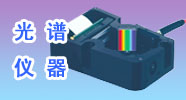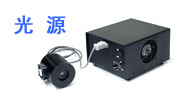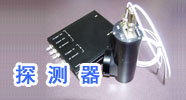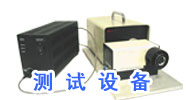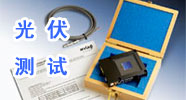|
|
|
Solar Cell Quantum Efficiency / Spectral Response / IPCE Measurement Systems |
|
|
|
|
|
Solar Cell Spectral Response / Quantum Efficiency / IPCE Measurement Systems
PVM offers a range of solar cell quantum efficiency measurement systems for photovoltaic cell testing, customized to be the best system for your measurement needs. The systems are built on the platforms of the QEX10 and the QEW7 Spectral Response Measurement Systems.
External Quantum Efficiency
Solar Cell Spectral Response Measurement Systems give detailed data on how efficiently a solar cell converts light into current at various wavelengths. PVM systems normally provide the data in Quantum Efficiency (QE) units, also known as External Quantum Efficiency (EQE) and Incident Photon Conversion Efficiency (IPCE).
The detailed performance information provided by a QE measurement is commonly used by researchers to document and answer questions about:
Device performance
Material purity
Material selection
Device design
Process steps
Internal Quantum Efficiency
Some of the light incident on a solar cell is reflected which reduces the amount of light entering the solar cell. If the power or irradiance of the reflected light is measured and subtracted from the known incident light quantity, the system knows how much light is entering the solar cell and can calculate Internal Quantum Efficiency (IQE). With the Reflectance Accessory, the QEX7 can measure the reflectance of a photovoltaic device and provide the solar cell IQE measurement.
Solar Cell Manufacturing Process Control
In manufacturing, regular sampling of the photovoltaic devices as they come out of the production line yields spectral response data that helps reveal which process steps need to be adjusted. Experienced operators can use the information to determine how processes need to be adjusted to maintain efficiency and quality.
QEX10 Quantum Efficiency Measurement System
PVM is proud to introduce the QEX10 Quantum Efficiency Measurement System.
The QEX10 Quantum Efficiency / Spectral Response (SR)/ Incident Photon to Current Conversion Efficiency (IPCE) Measurement System is the culmination of over 15 years of photovoltaics measurements and system design by a team dedicated to the advancement of photovoltaic device characterization.
Turn-key solution for solar cell analysis
System of choice by standards laboratories
Mature product - over 200 QE systems in the field
Fast and easy installation
Excellent repeatability
Accurate measurements
Built-in light bias and voltage bias
Light bias capability up to 150 mA
DC mode measurement capability (optional)
Measures reflectance and IQE/APCE (optional)
ASTM Method E 1021-06 compliant
The QEX10 Quantum Efficiency / Spectral Response / Incident Photon Conversion Efficiency Measurement System uses a xenon arc lamp source, monochromator, filters and reflective optics to provide stable monochromatic light to a photovoltaic test device. A broadband bias light also illuminates the test device to simulate end-use conditions. The system uses a detection circuit designed to maximize measurement speed and accuracy in solar cell research.
Multi - Junction Quantum Efficiency Measurements
The QEX10 includes a broad spectrum white bias light that can be used to bias most devices and provide almost any desired bias spectrum with the correct filtering. Using two or three bias lights, it is easier to get the correct bias light level for each junction. The correct bias lighting along with the correct voltage bias can allows the discerning scientist to make accurate measurements of each of the individual junctions in a multi-junction measurements.
High repeatability
The basic solar cell quantum efficiency measurement system wavelength range is 300 to 1100 nm. Repeatability is better than ±0.3 % in the 400-1000 nm range and better than ±0.6 % in the 300-400 nm and 1000-1100 nm ranges for p-n junction solar cells. The probe beam spectral bandwidth is approximately 5 nm (narrower or wider bandwidth can be obtained by adjusting the monochromator slits). The measurement interval is selectable and is set to 10 nm as a default. The graph on the left shows the relative difference between 5 measurements done on a single crystal Si sample and the average of those measurements.
The QEX10 Solar Cell Quantum Efficiency Measurment System Specification shows more details on the system. Please download it and review the table of options on page 3.
Measure the response of any solar cell
Measure the quantum efficiency of any type of solar cell, including:
Mono crystalline silicon solar cell (Si)
Multi crystalline silicon solar cell (mc-Si)
Amorphous silicon solar cell (a-Si)
Gallium arsenide solar cell (GaAs)
Gallium indium arsenide solar cell (GaInAs)
Gallium aluminum arsenide solar cell (GaAlAs)
Gallium indium phosphite solar cell (GaInP)
Cadmium telluride solar cell (CdTe)
Indium phosphite solar cell (InP)
Zinc oxide solar cell (ZnO)
Copper indium selenide solar cell (CIS)
Copper indium gallium selenide solar cell (CIGS)
Dye sensitized solar cells (DSSC) or DSC Dye sensitized cells
Inorganic solar cells
Organic solar cells
Polymer solar cells
Single junction solar cells
Multi junction solar cells
Substrate solar cells
Superstrate solar cells
QEW7 Solar Cell Spectral Response / QE / IPCE Measurement System
A tungsten filament light source, monochromator, filters, and reflective optics provide monochromatic light to a photovoltaic device while a broadband bias light illuminates the test device to simulate end-use conditions. The monochromator, filter wheel, and digital signal processing equipment are controlled by a computer, which also interprets signals, maintains calibration information, saves test data, and produces test reports. This system can measure a wide variety of photovoltaic devices, including p-n junction and dye-nanocrystalline solar cells.
Basic System Features
Dual grating monochromator with computer control
Filter wheel with order-sorting and stray light attenuation filters
Calibrated reference photodiode
Line filter for wavelength calibration verification
Simultaneous measurement of device response and light intensity
Computer system with easy-to-use graphical user interface
Monochromatic light spectral bandwidth approximately 5 nm (user-changeable)360-1100nm wavelength range
Selectable wavelength interval (default 5 nm)
Calculates Jsc estimate using reference spectrum
Voltage bias capability
White bias light source
Chopping speed 4-200 Hz
Measures silicon solar cell in 4-10 minutes Instruction manual
Customer training in Colorado
Options
Setup and training at customer's site
Test fixture and contacting mechanism for your devices
Temperature control for the optional test fixture
Multi-junction cell measurement capability
Other options are available; please contact us to discuss your requirements
Individual systems may vary in appearance,components, and features.
太阳能电池测试系统,太阳能电池测量系统,测试仪,测量仪
|
|
|
|
|
|
